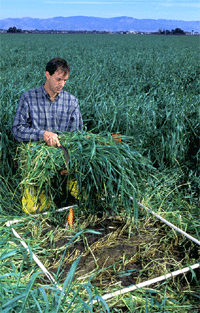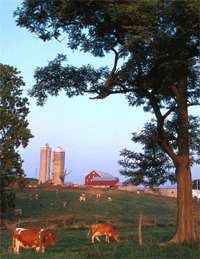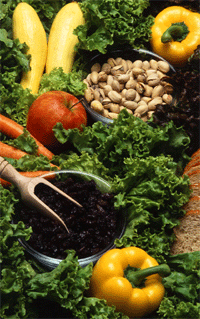Abstract

On a Salinas Valley, California, organic farm, horticulturist Eric Brennan harvests a bundle of a late-summer rye cover crop.
Photo by Scott Bauer ©2005 ARS |
This guide is to help organic producers and handlers understand, prepare for, and get the most from their annual inspections for certification of compliance with USDA National Organic Standards.
Table of Contents
Introduction
This publication provides checklists of the documentation needed for organic certification. These will help organic producers or handlers organize their paperwork for an organic inspection. It includes steps for preparing for the organic inspection and checklists of audit-trail documents and required records for certification of organic crop and livestock production and organic handling facilities.
Back to top
Inspection Preparation

Photo by Scott Bauer ©2005 ARS |
Organic certification is about verifying that you are managing an organic system to grow crops, raise livestock, and/or process food and fiber according to the National Organic Standards. An important part of being prepared is being able to track your product from the field or point of purchase to the consumer, ensuring that the product has been kept separate from non-organic products and has not been contaminated in any way by materials prohibited for use in organic production. Producers and handlers will find it useful to follow the following four steps to prepare for their annual inspection.
Review the sections of the National Organic Standards that are relevant to your operation
To their detriment, people often do not read the National Organic Standards. They may seem long and overwhelming, but if you are familiar with the key standards relevant to your operation, your inspection will make a lot more sense. Certifiers provide a copy of the standards with their application package, and the standards are also available on the NOP Web site.
These Standards were written to address most agricultural production and processing activities. Not all portions will be applicable to every operation. As you review them, look for and focus on the parts that do apply to your operation. The definitions in Part 205.2 will help you understand key terms.
- Crop Producers
Production Requirements in Sections 205.200 through 205.207
Materials on the National List in Sections 205.600 through 205.603
Recordkeeping in Section 205.103
Labeling in Sections 205.300 through 205.311
- Livestock Producers
Production Requirements in Sections 205.236 through 205.239
Materials on the National List in Sections 205.600 and 205.603-604
Recordkeeping in Section 205.103
Labeling in Sections 205.300 through 205.311
(Livestock producers who raise their own feed must also comply with the requirements for crop production.)
- Handlers
Handling Requirements in Sections 205.270 through 205.272
Materials on the National List in Sections 205.600 and 205.605-606
Recordkeeping in Section 205.103
Labeling in Sections 205.300 through 205.311
Review your Organic Systems Plan (OSP)
The OSP must be updated and submitted to your certifier whenever a significant change is made to your operation. Each certifier has particular forms and procedures for keeping OSPs current. In preparation for your annual inspection, verify that your OSP is current and complete, with all pertinent attachments. If you have not already submitted them to your certifier, be prepared to provide updates at the time of your inspection. Keep copies for your files. You must have a complete, current OSP on file at all times. Be prepared to show records of how you implement each part of your OSP.
Review any communications from your certifier that you have received in the past year

Photo by Scott Bauer ©2005 ARS |
Each year you will receive a letter that addresses your certification status. (Certifiers have different names for this letter: certification determination letter, notice of noncompliance, certification status report, remediation letter, conditions letter, evaluator's circle, etc.) Does this letter describe any areas in which your operation was found to be other than fully compliant by the previous inspection and review process? Have you resolved the issues that were raised after your previous inspection? Have you responded in writing to any requests made by your certifier? Can you provide documentation to show how you have addressed these issues? The annual inspection must verify that all previously cited noncompliances have been corrected. Be prepared to demonstrate and provide documentation that you have taken corrective measures and that your operation is fully compliant with the standards cited in the notice of noncompliance.
Communications from your certifier may also include general memos to all certified clients explaining updates to the lists of allowed or prohibited brand-name materials, changes or updates to manuals, renewal procedures, fees, inspection protocol, and interpretation or clarification of standards. The inspection and certification process will go more smoothly if you know what to expect and keep yourself educated about any changes that occur.
Gather your records using the following organic inspection checklists
Organic Inspection Checklists
The National Organic Standards specify that records must "fully disclose all activities and transactions in sufficient detail as to be readily understood and audited" (NOP Section 205.103(b)(2)). Are you prepared to explain your recordkeeping system? Is anything missing or incomplete? You can make your inspection easier and more efficient by doing a self-audit beforehand, using the following checklists. Please note that these lists are comprehensive, and some items may not apply to your operation.
Crop production documentation checklist
- List of crops being grown, field locations (maps), acreages, and estimated yields
- Field history or land use documentation, if any new land is added this year
- Field activity logs for all practices performed (cultivation, weed control, use of manure or fertilizers, spraying, pruning, beneficials released, etc.)
- Input purchase/source records of all inputs used for crop nutrients, pest, disease, or weed control
- Receipts
- Invoices
- Delivery tags
- Receipts or logs recording the pick-up or delivery of free materials
- Labels and/or documentation demonstrating that each material is allowed for use in organic production.
- A generic material (e.g., mined limestone) must be on the National List as allowed.
- A brand name product must either
- have a label that discloses all ingredients, including inert ingredients, so that they all may be verified as allowed; or
- be listed as an allowed brand-name material on a list approved by the certifier (e.g., the Organic Materials Review Institute (OMRI) Brand Names List, the Washington State Department of Agriculture (WSDA) list, or others). Find out from your certifiers whether they maintain their own list of approved materials, perform their own brand-name material reviews, or whether they honor other lists, and if so, which.
- Note that manure must either be composted according to NOP standards or its date of incorporation documented to comply with the required number of days before harvest of a crop intended for human consumption
- Input application records (material, source / brand name / manufacturer, regulatory status, field location, date, and rate or quantity used)
- Seeds (crop and cover crop), planting stock, annual seedlings, and transplants
- Seed coatings and inoculants
- Greenhouse materials (e.g., potting soils or soil mix ingredients)
- Crop nutrients and soil amendments
- Pest management materials
- Beneficial insect releases
- Natural, organic, or plastic mulches
- Any other materials applied
- Seed, planting stock, and transplant records
- Documentation that seeds and annual transplants are certified organic, or
- For any non-organic seed or planting stock used, documentation of:
- Your unsuccessful search for commercially available organic seed or planting stock (most certifiers require documentation of non-availability from three sources), and
- Verification that the seed or stock used is not genetically modified or treated with prohibited materials
- Documentation of compliance of any inoculants or seed coatings (non-GMO status of inoculant organisms and allowed status of all seed coating materials)
- Audit trail documents that track products from the field of origin to final use or sale. A random audit is part of inspection procedures. It may require the following.
- Field, planting and production records
- Harvest and yield records
- Post-harvest handling records
- Storage records
- Transport records
- Sales records
- Soil management activities, including crop rotation and erosion prevention activities
- Pest management activities for control of crop pests (insects/mites/invertebrates/vertebrates), diseases, and weeds, including:
- Preventative practices
- Materials used, if any
- Pesticide use reports, as required by law, if applicable (Some states require reporting of all applications of EPA-registered materials to commercial crops to the County Agricultural Commissioner, Department of Weights and Measures.)
- Organic Integrity: Documentation of measures to avoid contamination and commingling, as applicable to your operation
- Information about neighboring land use
- Prevention of contamination from borders
- Production, harvest, and sales records for buffer crops, transitional or conventional crops
- Material storage: adequate separation of allowed materials from any non-allowed products
- Irrigation water and system for contamination prevention (i.e., diagram of valves, backflow prevention, and/or documentation of purge or flushing procedures to prevent contamination from shared water systems where fertilizers or other prohibited materials are used)
- Clean-out or purge logs for equipment used for both organic and conventional operations
- Documentation of procedures to verify the absence of sanitizer residues, if sanitizers are used
- Certification documentation of any organic product purchased for resale
- Labels and labeling
- Printed packaging, bags, boxes, ties, bands, and stickers
- Lot numbering of retail and bulk products, if applicable
Livestock Production Documentation Checklist
- Animal lists, including livestock or poultry descriptions and/or numbers and identification methods
- Source of poultry and/or livestock, including breeding, birth, hatching, and/or pur- chase records
- Feed harvest and storage records
- Feed rations for each type of animal during each stage of growth and development
- Feed and feed supplement purchase records and documentation that they are certified organic or allowed
- Drinking water, including source, additives, potential sources of contamination, and results of any water analysis
- Audit trail documents that track animals or animal products (harvest or slaughter, processing/post-harvest handling, transport, and sales records)
- Housing and living conditions, including grazing management and outdoor access records
- Animal medications, including a list of all products used or that may be used (everything in your medicine cabinet or refrigerator, with product names, ingredients, manufacturers, and regulatory status)
- Health management records, including vaccinations and all other materials, veteri- narian bills, purchase invoices, records of medication used, reason for use, and animal identification
- Marking and segregating methods for animals treated with prohibited materials
- Soil management, erosion control, crop nutrition, and pasture management
- Manure management (must not contribute to contamination of crops, soil, or water)
- Pest management, including parasite management
- Off-site processing records, including slaughter, cold storage, and meat packing (These activities must take place at facilities that are already certified organic, or they must be inspected as part of your operation.)
- Product or animal sales records
- Labels, if applicable
Handling Production Documentation Checklist
- Product identification and composition for all organic products produced (This must include current formulations, recipes, or batch sheets that support the percentage of organic ingredients in your product label claim—"100% Organic," "Organic," or "Made with organic….")
- Facility map(s) showing the facility perimeter and buildings, all equipment, and areas used for receiving, raw material storage, processing, packaging, finished product storage, and shipping
- Production flow chart(s) that includes equipment used in each step or stage of the process and shows the flow of products through the facility from receiving of raw ingredients to shipping of the final product
- Documentation of sources of ingredients and processing aids
- Organic ingredients and processing aids: You must have on file a copy of the organic certificate from the supplier of any organic ingredient or processing aid, showing that it is certified to NOP standards, along with the level of certification that supports the label claim you intend to make For example, if your label makes the claim of 100% organic, all ingredients and processing aids must be documented to be certified as 100% organic.
- Non-organic agricultural ingredients and processing aids: You must provide documentation affirming that each specific ingredient a) is not commercially available as organic, b) does not contain prohibited inputs and has not been produced using prohibited methods (genetic engineering), c) has not been treated with ionizing radiation, and d) is not produced from a crop grown using sewage sludge.
- Non-agricultural ingredients: All nonagricultural ingredients must be listed on and consistent with the annotations of the National List (NOP Sections 205.605 through 205.606).
- Pest management
Documentation for preventative practices, procedures, maps, logs, service reports, and incident records must be provided. Whether your pest management is done in-house or by a contracted pest control company, you must document what materials are used, if any, including maintaining product labels or MSDS pages on file. If prohibited materials (substances not on the National List) are used inside your facility, be prepared to show documentation of how organic products and materials are protected from contamination during pest control applications.
- Sanitation
You will need documentation of standard operating procedures, equipment cleaning, equipment purge logs, and residue testing. Residue test procedures must be appropriate for the sanitation materials used. For example, if chlorine is used as a sanitizer, a chlorine test strip with sensitivity in the low (0-10 ppm) range must be used to show that the level of chlorine remaining is below 4 ppm, the level allowed in NOP section 205.606. Materials that are not listed as allowed sanitizers are now allowed, but if they are used, they must be completely removed before running organic products. For example, if acid or alkaline sanitizers are used, a pH test with a neutral result (or one that matches the plain water used in the facility) indicates that the sanitizer material has been washed off. Quaternary ammonia is not listed and not allowed, and therefore must be completely removed, such that there are no detectable residues, and residues do not contaminate organic products. Records must be maintained for each area or production line where organic processing occurs, showing how organic products and packaging materials are protected from contamination by conventional product residues and/or sanitation chemicals on food contact surfaces.
- Water
You will need documentation of source, use, additives, and any applicable tests results.
- Culinary steam
Provide a list of all boiler additives, MSDS pages for all additives, results from any carryover tests, and explain how the organic product is protected from boiler additive contamination.
- Organic integrity (organic critical control points)
You will need documentation of systems and procedures to prevent commingling and/or contamination of organic ingredients and products throughout all steps of processing.
- Audit trail/audit control documents
The organic recordkeeping system must accomplish two objectives: 1) trace products as certified organic from the raw ingredients to final sale (for verification of sources and/or sample recall from final destination); and 2) verify the input–output balance of organic ingredients and organic products, including current inventory. Be prepared to supply samples of paperwork during the inspection to track ingredients to finished products for any item and for any time that may be randomly selected for an input/output audit.
- The audit documents for purchase, receiving, storage, production, packaging, handling, transport, and sales may include, but are not limited to, invoices, weight slips, purchase orders for incoming materials, invoices for finished product, descriptions of product tracking or coding, logs for receiving, processing, storage and inventory systems, transport cleaning documentation for incoming and/or outbound materials, and product labels.
- The input/output balance audit documents may include, but are not limited to, inventory, purchase, production, and storage records—including typical conversion figures for shrinkage, reconditioning, donated products, samples, dumping, shipping, and sales records.
- Labels and labeling
You will need finished product labels (retail and wholesale labels on printed packaging, boxes, etc.), with the proper placement of the phrase identifying the certifier, relative size of USDA and certifier logos, lot number, and market destination, as applicable.
- Off-site storage/contracted facilities
If your operation uses off-site, contracted warehousing or outside contractors for handling of ingredients or finished products, you will need to provide information about how the off-site facility is used. Depending on what they do, such facilities may need to be certified to operate under the certificate of the entity for whom they provide custom services, or provide an affidavit that they meet the criteria of an excluded operation (see NOP Section 205.101 for definitions and requirements).
General Checklist for all Organic Operations
- Current state organic registration (Department of Food and Agriculture or Department of Health Services), if applicable
- Complaint Log (procedure for response to any complaints related to organic integrity). This is an ISO 65 requirement if any products are to be exported.
- Documentation and/or demonstration of the correction of previously cited issues of noncompliance
Checklist for Planning for Inspection Day
- Ensure that you can devote the time and attention needed to complete the inspection.
- Make prior arrangements for someone else to handle work-related tasks and/or family commitments.
- Have all your records ready and accessible.
- Provide a space where you and the inspector can comfortably review records. While a tailgate may suffice for some operations on a sunny day, a clear table and place to sit out of the wind and weather are preferable. Some inspectors require space for a laptop computer.
- Be prepared to provide easy and prompt access to all fields, buildings, and storage areas, both on- and off-farm. This may include having keys to gates and sheds and having other management personnel available. If you have multiple fields or sites, be sure to advise your inspector, so that sufficient time is alloted for your inspection.
- Have enough gas in the pickup (or other appropriate vehicle) to reach the more remote parts of the farm or facilities.
Back to top
Summary
The on-site inspection is an important part of the organic certification process. It can be useful to you as an organic producer or handler in at least two significant ways: a) by providing you with a certificate of organic certification to the USDA National Organic Standards and other applicable standards and b) by providing the impetus and inspiration to develop and implement organic systems for production and handling and their corresponding record-keeping systems. This publication is intended to show how organic production or handling systems and sound record-keeping systems reinforce each other to support continuous learning about organic systems design and good business management.
Back to top
References
Biodynamic Farming and Gardening Association
www.biodynamic.org.nz/demeter.html
International Federation of Organic Agriculture Movements
www.ifoam.org
International Organic Inspection Manual IFOAM and IOIA, December 2000.
Order from:
Independent Organic Inspector's Association (IOIA)
P.O. Box 6
Broadus, MT 59317-0006
406-436-2131 (telephone/FAX)
ioia@ioia.net
www.ioia.net
The National Organic Program (NOP)
www.ams.usda.gov/nop
Organic Materials Review Institute
www.OMRI.org
Back to top
Acknowledgements
Thanks to Brian Magaro and Lois Christie, organic inspectors who provided their pre-inspection letters as resources for developing this publication.
Appreciation to the following reviewers:
- Luis Brenes, Organic Inspector and Trainer
- Lois Christie, Fiesta Farms
- Doug Crabtree, Montana Department of Agriculture, Organic Certifier
- Jeff Cunningham, Organic Inspector
- George Kuepper, Program Specialist, NCAT
- Nancy Matheson, Program Specialist, NCAT
- Jim Riddle, Organic Independents
Preparing for an Organic Inspection: Steps and Checklists
By Ann Baier
NCAT Agriculture Specialist
Copyright © 2005
National Center for Appropriate Technology
IP261
Slot# 265
Version 030105
Back to top |






